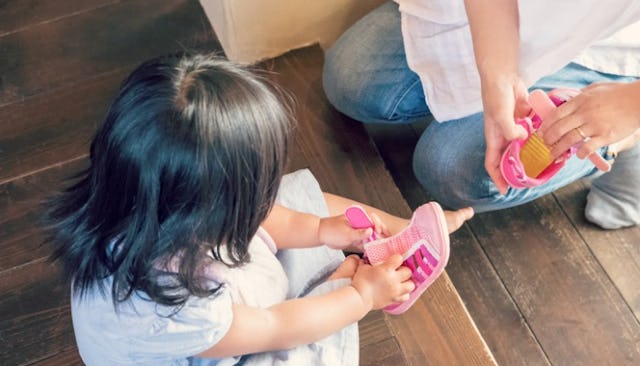In Defense Of Letting Our Young Kids Make (Some Of) Their Own Choices

My daughter was about 2 1/2 when I first heard her utter the words, “I no want it.” I was getting her ready for Grandparents’ Day at school and pulled out a precious dress for her to wear. The conversation went something like this: Audrey, grabbing the hem of the dress and shaking her head, “I no want it.”
Understandably shocked, I questioned, “What do you mean you don’t want it? Of course you want this! This is adorable!” In my defense, it was adorable. Fine wale corduroy animal print dress with a bishop collar and hot pink trim, what’s not to love?
“I no want it.”
I took a deep breath, a mental step back, and let her choose. For me, her selection fell into the “play clothes” category and not really the “Grandparents’ Day” one, but she looked adorable. And most importantly, she was satisfied with the opportunity to choose and was happy with her selection.
Whether we like it or not, at the earliest age, our children have a sense of self. They have preferences. These might not be our preferences, of course, but who am I to say what’s right?
I think as parents we can get caught up in the fear of what other people will think. Not only about what others will think of us as parents, but what other kids will think of our kids. As an adult, I know that what other people think of me is none of my business. For kids, however, it may not always be that easy; there may be struggle. Like it or not, we are hardwired as humans to struggle. The important thing is to give our children the opportunity to cope with the struggle instead of rushing in to save them from ever having to struggle.
A relative once shared an instance when her young son wanted to go to preschool wearing his sister’s pink barrette in his hair. She asked him if he might want to just carry the barrette with him instead of wearing it. His choice was to wear it pinned into his beautiful blonde hair. She hugged him tight and wished him to have the best, most fun day. My daughter’s socks rarely ever match — by choice. My son once asked me to paint his fingernails yellow — and to wear it to daycare. I offered the option of wearing the nail polish only for the weekend, but he chose to try it out during the week. I, too, sent him on his way wishing him the happiest of days.
By supporting their choices, we instantly communicate how much they are loved no matter what. We are telling them that their choices matter and that they are good, valued, and loved even with pink barrettes, yellow nail polish, and mismatched socks.
So what is our message when we tell them no?
I can’t say with absolute certainty what this means for our children. I’m sure that the little boy who wore the barrette may have gotten some giggles or even a few high fives. It’s possible that my daughter has received a strange look or comment about her socks. I would bet at least one child asked my son why his nails were yellow.
I would argue, though, that whatever they experienced, they all learned something. He possibly learned what it means to be courageous. She may have learned what it’s like to feel different and whether or not that is okay with her. He may have learned how to deal with embarrassment or even how to handle loads of positive attention.
I know for sure they learned that within the space of life, they can make choices, and no matter the outcome, they will always have a soft place to fall — into the loving and accepting arms of their mother.
Letting them be who they are. Enjoying and loving them through every questionable ensemble, yellow nail polish, and pink barrettes, reminding them of their awesomeness each and every step of the way.